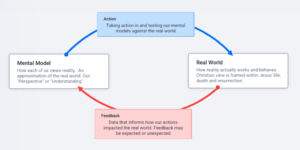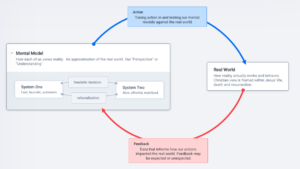Ain’t Nothing Like the Real Thing
“I’ve got your picture hangin’ on the wallBut it can’t see or come to me when I call your name.I realize it’s just a picture in a frame.Ooh, I read your letters when you’re not nearBut they don’t move me and they don’t groove meLike when I hear your sweet voice whispering in my ear.
Ain’t nothing like the real thing, baby,Ain’t nothing like the real thing.” [1]
The Gift that Keeps Giving
For my birthday in 2018, a good friend gave me a copy of Daniel Kahneman’s “Thinking Fast and Slow.” Today, I consider it one of the most influential books in shaping my thinking and one of my best birthday gifts ever (though some way behind the red 12-speed mountain bike of my 11th birthday–12 speeds!)
I find it remarkable that this book has been so impactful on my own thinking since one of the main points of Kahneman’s work is that significant parts of our thinking, the ‘System One’ parts, are essentially on ‘autopilot’ all the time–quick to respond, heuristic in nature, and rationalized by the slowly-mobilized, calculating and effortful ‘System Two.’ [2] I’ll be honest, seven years after reading and re-reading this book multiple times I’m still not sure how to apply everything within in. In Adler’s categorization of books, this is one of those rare ones that I get something new from every time I come back to it. It grows with me [3].
In a previous reading, Kahneman’s description of “Life as a Story” caught my attention, particularly “Amnesic Vacations.” [4] In response, I decided to take fewer photos when traveling and seeing new places. I do still take photos, but I often choose to forego the urge to pull out my phone immediately and may only take one or two, if any. It is not only a decision to optimize the experience of the moment, but it is also my silent shout of resistance to the forces of technopoly [5]; forces would tell me that my quality of life experience will be measured by the publication of my photo on social media and the corresponding number of reactions to it. Freya India gives a brilliant and insightful response to the effect of this dynamic on our relationships in her article, “Your Boyfriend Isn’t Your Camera Man” [6]. So, thank you, Danny Kahneman, on behalf of my family and our holidays.
What has stood out to me in this most recent reading, and having incorporated thoughts from other recent readings, is what it takes to learn. Chiefly, that receiving information isn’t enough. Having information creates an opportunity, but if maturity happened simply through accessible information, we would be living in the most stable and mature generation of all time. And yet, the evidence points toward us either being “stuck in a rut” or even regressing when it comes to emotional maturity [7].
Kahneman says it this way:
“People who are taught surprising statistical facts about human behavior may be impressed to the point of telling their friends about what they have heard, but this does not mean that their understanding of the world has really changed. The test of learning psychology is whether your understanding of situations you encounter has changed, not whether you have learned a new fact… You are more likely to learn something by finding surprises in your own behavior than by hearing surprising facts about people in general.” [8]
Note: “finding surprises in your own behavior.”
Wanting to Learn the Hard Way
I have sometimes wondered why when, as a parent, I give my child the choice of heeding my advice or trying and finding out something for themselves, they choose the latter. What I would have called “the hard way.” Kahneman shines some light on why. The experience of discovering an obstacle isn’t a hindrance–it is the learning.
I am currently working with a team to determine how best to prepare and care for volunteers who join our organization. Some come for short-term periods, less than one year, and some serve for multiple years. We recognize that they all have different needs, but one thing they all have in common is a need for intercultural competence to function well within a setting that includes 40 to 50 different nationalities.
Can a training program do this? I’m doubtful myself.
Perhaps presenting information can provide some opportunity to learn, but I don’t see a substitute for experience for learning and application. I reflect on my own experience, which includes feeling the pain of running into the emotional glass doors of differences in worldview, family, culture, dogma, or language. You just don’t see them until you are embarrassed and in pain.
Perhaps that’s because to learn is to experience and resolve tension. Crossing liminal thresholds [9] comes with an associated degree of difficulty while in the liminal state, and experience is the place where our understanding of the world meets the reality of how the world actually works.
Mental Models for Metanoia
A few years ago, I developed a model that helps introduce people to this concept of mental models and feedback loops in our thinking and experience:
I believe that this principle is demonstrated in biblical texts when Job says, “My ears had heard of you, but now my eyes have seen you” (Job 42:5) or when Thomas is invited to put his hands on Christ’s body after the resurrection (John 20:26-29). There is no substitute for experience. Through our interactions with the real world, we repent (meta-noeo, change of mind. Matthew 4:17, among other references), and our thinking is transformed. Romans 12:2 presents this transformation in the context of reality being defined not by our faulty understandings of the world, but by God’s intent and design.
While the model above is relatively simple (by intent and design), it can also be modified to accommodate the truths in Kahneman’s work. The following is a significant simplification of Kahneman’s work, but it could be considered a “next step” concept.
Learning Differently
Recognizing that, as Kahneman describes, many of our choices, biases, and errors are a result of the dynamics of System One and System Two, I am prompted to think differently about the learning, teaching, and training I am working on with my group.
What if an information-based training program wasn’t the solution we needed? What if, instead, we provided a way to help people understand how we learn (real Humans, that is, not Econs [10]) and then encouraged the experience of sitting in the liminal space and reconciling their own mental models with experienced reality? Would we see more breakthroughs where people understood cross-cultural relationships because they experienced them in a story they were a part of, a context of self-awareness of their own mental models (perhaps with some supporting mentoring)?
I look forward to exploring this in practice and finding out if Marvin and Tammy were right–that there just “ain’t nothing like the real thing” when it comes to learning from experience.
I’d love to hear your opinion on this, especially if you have any background in learning, training, or formation.
Notes
[1] Marvin Gaye and Tammi Terrell, Ain’t Nothing Like the Real Thing (Tamia, 1968).
[2] Daniel Kahneman, Thinking, Fast and Slow, First paperback edition, Psychology/Economics (New York: Farrar, Straus and Giroux, 2013), 24-25.
[3] Mortimer Jerome Adler and Charles Van Doren, How to Read a Book, Rev. and updated ed (New York: Simon and Schuster, 1972), 332-334
[4] Kahneman, Thinking, Fast and Slow, 388-389.
[5] Nicholas Smyth, “Smash The Technopoly!,” March 9, 2023, https://www.afterbabel.com/p/smash-the-technopoly?r=2cgdda&utm_medium=email.
[6] Freya India, “Your Boyfriend Isn’t Your Camera Man,” March 9, 2023, https://www.afterbabel.com/p/your-boyfriend-isnt-your-camera-man.
[7] Edwin H. Friedman, A Failure of Nerve, Revised Edition: Leadership in the Age of the Quick Fix, Revised Edition (La Vergne: Church Publishing Incorporated, 2017), 2-5.
[8] Kahneman, Thinking, Fast and Slow, 174.
[9] Jan Meyer and Ray Land, Overcoming Barriers to Student Understanding: Threshold Concepts and Troublesome Knowledge (London: Routledge, 2006), https://doi.org/10.4324/9780203966273.
[10] Kahneman, Thinking, Fast and Slow, 411,
4 responses to “Ain’t Nothing Like the Real Thing”
Leave a Reply
You must be logged in to post a comment.


Joff, I love this line and wanted to highlight it: Having information creates an opportunity, but if maturity happened simply through accessible information, we would be living in the most stable and mature generation of all time.
As for your question, What if, instead, we provided a way to help people understand how we learn (real Humans, that is, not Econs) and then encouraged the experience of sitting in the liminal space and reconciling their own mental models with experienced reality?
Is that what is being modeled in this program?
I’m just not sure how Haley will react when I tell her I have 4,500 candidates for the doctoral program.
In seriousness, I think you’re right. Perhaps the question should be how to translate the principles to a different context.
Your post, much like the book, is so full of information that I am reaching mental overload with how much I can comprehend. (This is a compliment to your mental capacity)
Reading your post gave me a more practical approach to how I can utilize the information in this book. I can get so stuck in the existential that I can’t figure out how to apply it. Your example of kids choosing the hard way helped to me apply the experiencing and remembering self who’s interests don’t always align. Both need to be considered in a persons well-being of what they want and what they think about their lives (410). Our desire for pain to be short-lived and pleasure to be enduring falls short as our memories tend towards duration neglect (384-85). I find the inconsistencies annoying.
You inspired me to go back and read slowly through chapter 36, “Life as a Story”. I can take your lead in having the book on hand to pull resources on in the different experiences of my life. I don’t need to eat the whole 10 layered cake in one week. I can savor it over time. Thanks for the encouragement to do so!
Jess, your good-natured and down-to-earth annoyance by the inconsistencies made me smile. It’s good to be human!
I have gone back to this book many times. I hope it grows on you like it has on me!